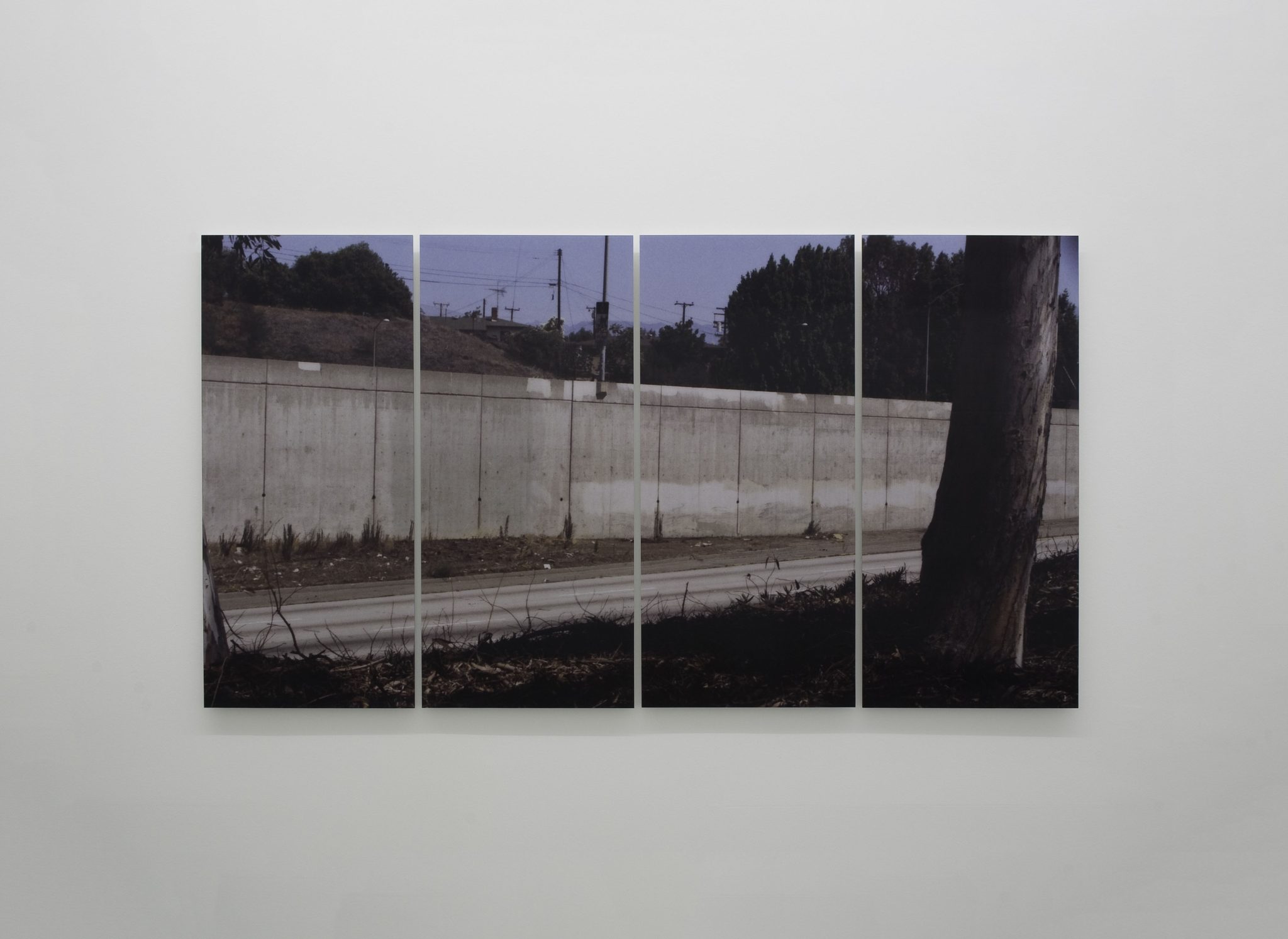Images
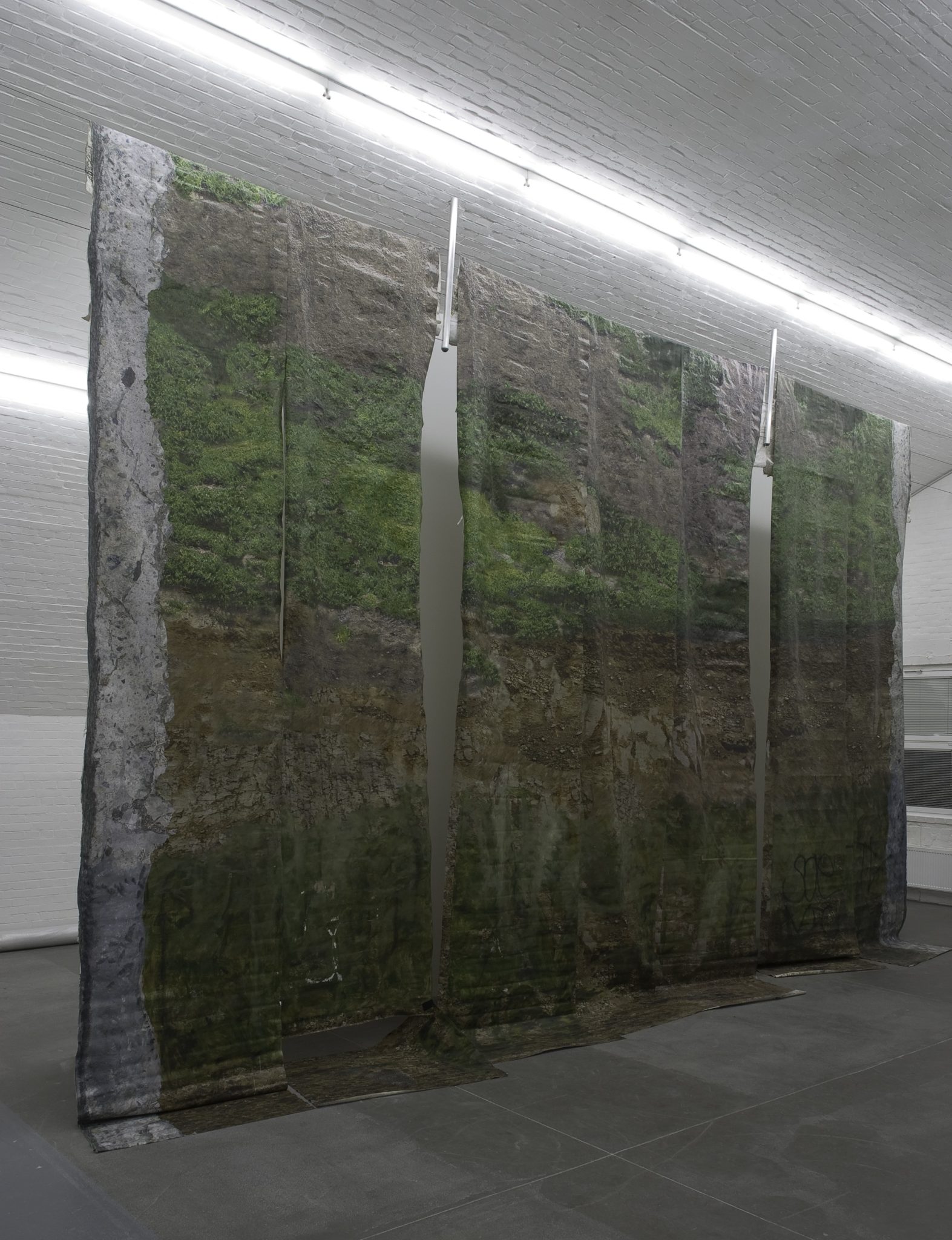
Ruben Ochoa
Remnants of a Fwy Wall Extraction/ Wallpaper with the Sounds of its Own Removal, 2006/ 2008
Remnants of a Fwy Wall Extraction/ Wallpaper with the Sounds of its Own Removal, 2006/ 2008
Digital print, spray paint, acrylic on vinyl wallpaper, wall paper paste, concrete, fencing posts, steel cables, 55 minute CD with sound
Variable dimensions (7 strips, each approx 8 m x 1.2 m)
Courtesy of Susanne Vielmetter Los Angeles Projects
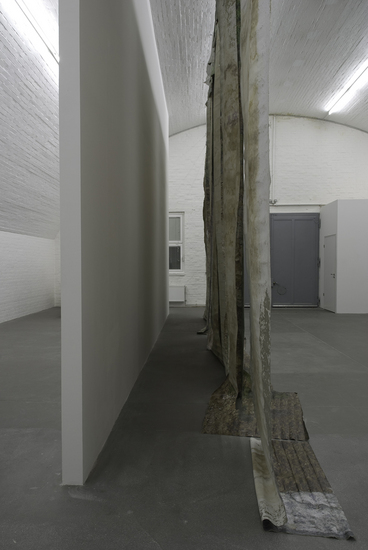
Ruben Ochoa
Remnants of Fwy Wall Extraction I, 2006/2007
Remnants of Fwy Wall Extraction I, 2006/2007
Digital print, spray paint, acrylic on vinyl wall paper, wallpaper paste, concrete, fencing posts, steel cables, 55 minute CD with sound
Variable Dimensions (7 strips, each approx. 8 m x 1,2 m)
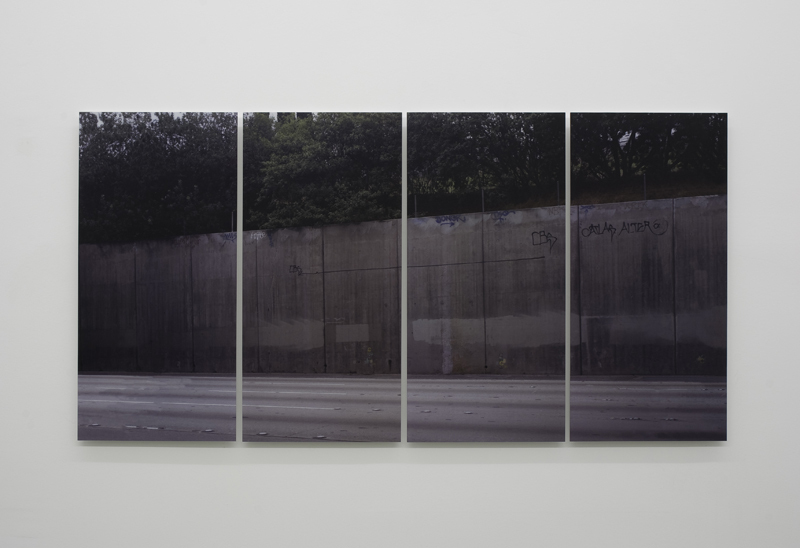
Ruben Ochoa
What if walls created spaces?, 2007
What if walls created spaces?, 2007
Lenticular print mounted on Diebond, Edition of 3 + 2 AP
48" x 96" (4 panels, each 48" x 24")

Ruben Ochoa
"What if walls created spaces?," 2007
"What if walls created spaces?," 2007
Lenticular print mounted on Diebond, Edition of 3 + 2 AP
48" x 96" (4 panels, each 48" x 24")
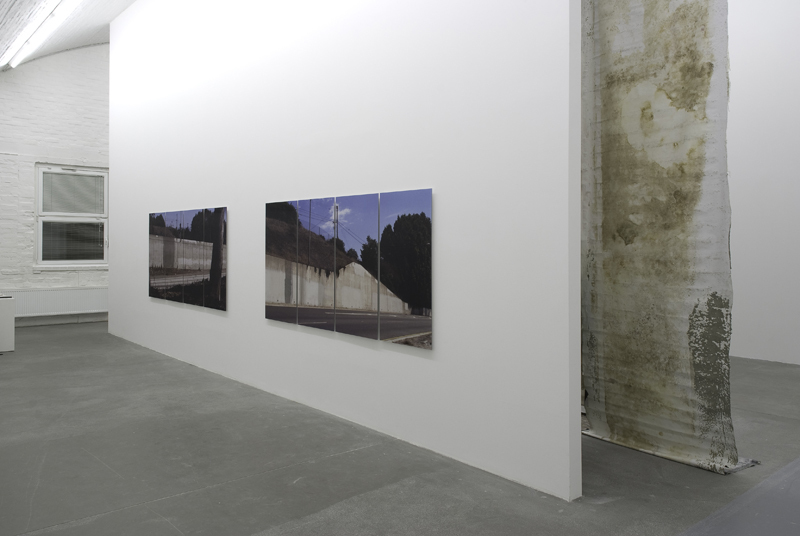
Ruben Ochoa: Fall of the Wall [paper]
Installation view
Installation view
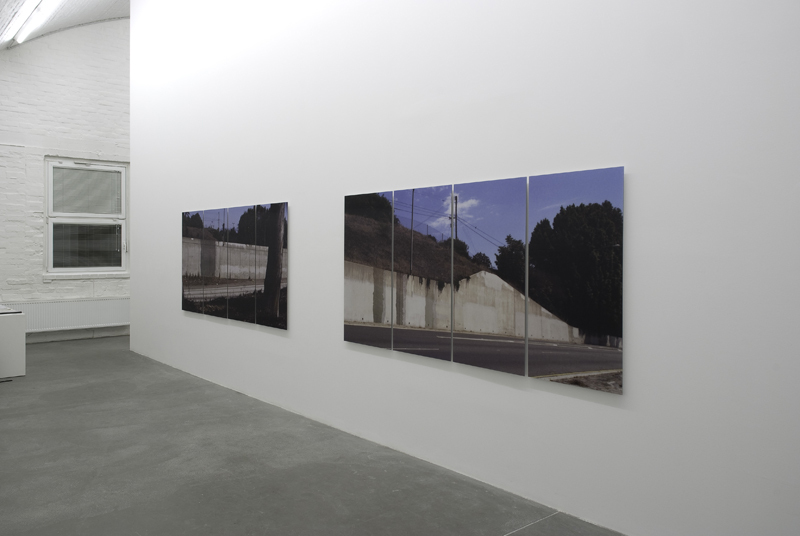
Ruben Ochoa: Fall of the Wall [paper]
Installation view
Installation view
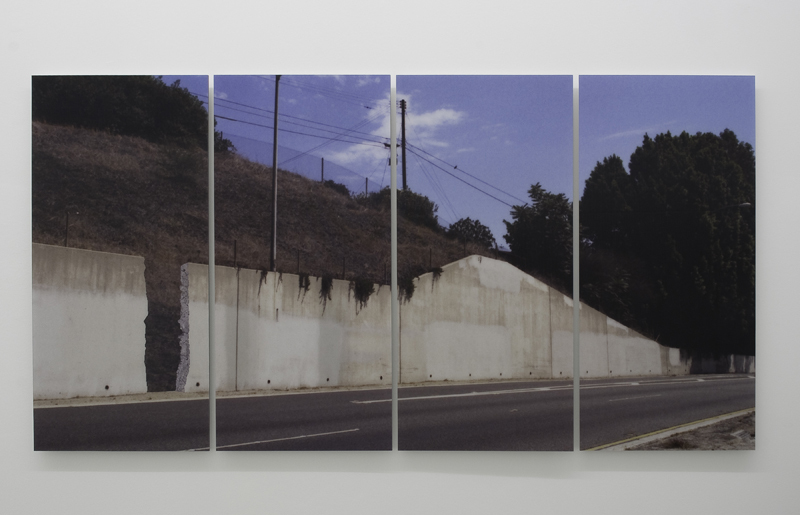
Ruben Ochoa
What if walls vanished from the freeway, would it make a sound?, 2007
What if walls vanished from the freeway, would it make a sound?, 2007
Lenticular print mounted on Diebond, Edition of 3 + 2 AP
48" x 96" (4 panels, each 48" x 24")

Ruben Ochoa
"What if walls vanished from the freeway, would it make a sound?," 2007
"What if walls vanished from the freeway, would it make a sound?," 2007
Lenticular print mounted on Diebond, Edition of 3 + 2 AP
48" x 96" (4 panels, each 48" x 24")
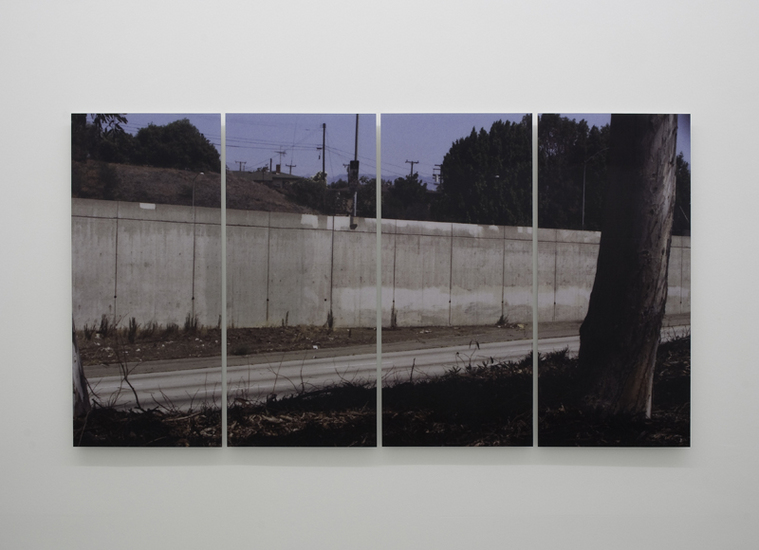
Ruben Ochoa
"What if walls made things greener on the other side?," 2007
"What if walls made things greener on the other side?," 2007
Lenticular print mounted on Diebond, Edition of 3 + 2 AP
48" x 96" (4 panels, each 48" x 24")
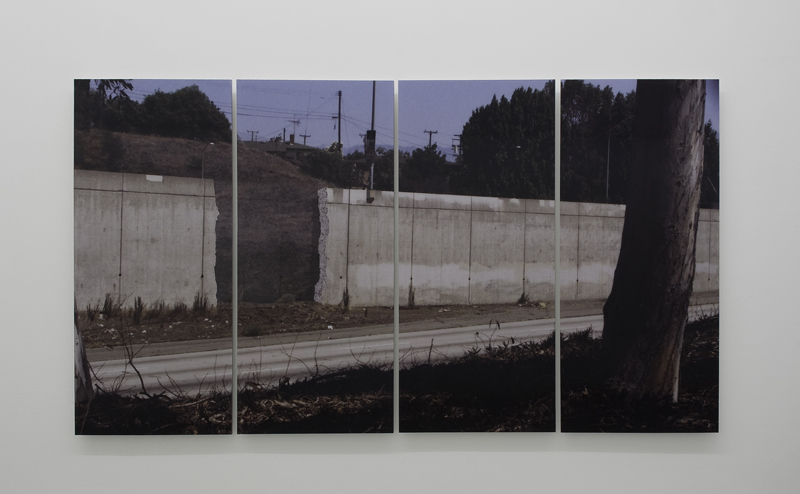
Ruben Ochoa
What if walls made things greener on the other side?, 2007
What if walls made things greener on the other side?, 2007
Lenticular print mounted on Diebond, Edition of 3 + 2 AP
48" x 96" (4 panels, each 48" x 24")
Press Release
Susanne Vielmetter Berlin Projects is pleased to announce a solo exhibition of new works by Ruben Ochoa. Ochoa, whose work will be included in the upcoming Whitney Biennial, will present a body of work that presents the third component in a series of projects spread out over the last two years. The first part, a public art project realized in Los Angeles last year, consisted of large scale photographic landscape images that were wall papered on the concrete retaining walls of the Santa Monica freeway. The photographs depicted sections of the kind of landscape one would expect behind the concrete walls. Commuters rushing by the installation had the impression of an actual opening in the wall with a view of the landscape behind it – a gap in the endless concrete boundary that so physically and metaphorically defines the city.
The second part of the project became manifest in the fall of 2006, when Ochoa placed the “removed” freeway wall section into the gallery space of LAXART, a nonprofit gallery in the heart of Culver City and adjacent to the Santa Monica freeway. Visitors to the gallery found themselves confronted with a massive concrete wall, awkwardly tilting against the gallery wall, from which an enormous mass of dirt spilled forward. Upon walking around the massive installation to the back of the sculpture they found that the piece was constructed from chicken wire and burlap, and only covered with the thinnest veil of dirt. The installation carried on the optical tongue in cheek attitude of the earlier piece, but it also provided a powerful symbol for the separation that urban architecture forges and for the uneasy relationship between nature and the city it commands.
For the third part of the project, Ochoa presents the landscape wall papers that were originally applied to the Los Angeles freeway walls in the gallery space in Berlin. Removed from the concrete walls, the landscape images hang from the ceiling of the space as soft, skin-like remnants. Bereft of the muscular support of the massive architecture beneath them, they allude to a softer and somehow melancholic reality. It was important to Ochoa that the gallery is situated in such close vicinity to the Berlin Wall, a reference that adds another range of connotations onto the project. Small bits of concrete are still stuck to the back of the paper, and the front shows traces of painting where the artist painted over the daily occurring graffiti doodles. The city of Los Angeles had required Ochoa to remove any signs of graffiti within 48 hours of their occurrence, so the wallpaper becomes a direct reflection of the history of these interventions in layers of green, gray, and earth-colored paint. Its painterly surface, its skin-like texture, and its soft posture undermine a concrete wall’s authority.
Ruben Ochoa graduated from the University of California, Irvine, with a MFA in 2003. His work was recently shown in solo exhibitions at LAXART in Los Angeles, at Hallwalls Contemporary Art Center, Buffalo, NY, and in a two person exhibition with Mark Bradford at the Los Angeles County Museum of Art. He was awarded a Creative Capital Grant in 2005 for his Freeway Wall Extraction project, and he was featured in the 2004 California Biennale at the Orange County Museum of Art. He will be included in the upcoming “Phantom Sightings” exhibition at the Los Angeles County Museum of Art, in a solo exhibition at Site Santa Fe, and in the Whitney Biennial at the Whitney Museum of American Art in 2008.
Exhibitions in the new gallery space will alternately showcase artists represented by Susanne Vielmetter Los Angeles Projects and by Praz Delavallade Gallery, Paris. Please contact Joanna Szupinska at [email protected] for questions relating to the artists and upcoming exhibitions. Questions regarding general information and press material should be addressed to Tobias Vielmetter at [email protected]. Susanne Vielmetter can be reached at [email protected].
Susanne Vielmetter Berlin Projects is located at Holzmarktstrasse 15/18 in Berlin Mitte. From the U/S train stop Jannowitzbrücke turn right and walk approximately 300 meters towards the “Aral” gas station. At the “Aral” gas station turn right towards the galleries which are located in the arched spaces underneath the rail road tracks. Gallery hours are Tuesday – Saturday from 11 am – 6 pm.
Wir freuen uns, neue Arbeiten des US-amerikanischen Künstlers Ruben Ochoa in unserem Ausstellungsraum in Berlin präsentieren zu können. Ochoa, der in der kommenden Whitney Biennale vertreten ist, wird eine Gruppe von Arbeiten zeigen, die den Abschluss einer Projektreihe darstellt, die er über die letzen zwei Jahre hinweg entwickelt hat. Ihr erster Teil, eine Installation im öffentlichen Raum in Los Angeles, die er im vergangenen Jahr realisiert hat, bestand aus großflächigen Landschaftsfotografien, die auf den Betonwall des Santa Monica Freeway tapeziert wurden. Die Fotografien zeigten Ausschnitte der Landschaft, die man hinter den Betonmauern vermuten würde. Auf an der Installation vorbeifahrende Pendler mussten sie wie tatsächliche Öffnungen im Beton wirken, die den Blick auf die dahinter liegende Landschaft freigeben – eine Lücke in der endlosen Betonumrandung, die die Stadt definiert, sowohl physisch als auch metaphorisch.
Der zweite Teil des Projekts wurde 2006 umgesetzt: Ochoa platzierte einen „entwendeten“ Teil der Freeway-Wand im Galerieraum vom LAXART, einer nichtkommerziellen Galerie im Herzen von Culver City, angrenzend an den Santa Monica Freeway. Galeriebesucher fanden sich konfrontiert mit einer massiven, steil zwischen Decke und Boden lehnenden Betonwand, von der aus sich eine enorme Menge Dreck in den Raum ergoss. Gingen sie um diese gewaltige Installation zur Rückseite der Skulptur, so wurde sichtbar, dass sie nur mithilfe von Hühnerdraht und Sackleinen konstruiert und mit einer nur sehr dünnen Erdschicht bedeckt war. Die Installation setzte die ironische Haltung der vorigen Arbeit fort, aber lieferte außerdem ein kraftvolles Symbol für die Spaltung, die urbane Architektur hervorbringt und für das unausgeglichene Verhältnis zwischen Natur und Stadt, das diese Spaltung herbeiführt.
Für den dritten Teil des Projekts präsentiert Ochoa die ursprünglich auf die Freeway-Wände in Los Angeles applizierten Landschaftstapeten im Berliner Galerieraum. Von den Betonwänden abgelöst hängen die Landschaftsbilder hier von der Decke herab wie weiche, hautähnliche Reste. Des strukturgebenden Halts der massiven Architektur beraubt verweisen die Fetzen auf eine weichere und gleichsam melancholische Realität. Wichtig für Ochoa war es, dass sich die Galerie in solch dichter Nachbarschaft zur Berliner Mauer befindet – ein Bezug, der dem Projekt eine Fülle weiterer Konnotationen verleiht. Kleine Betonstücke kleben immer noch an der Rückseite des Papiers und die Vorderseite weist Farbspuren auf, die markieren, wo der Künstler die täglich neu auftauchenden Graffitis übermalte. Die Stadtverwaltung von Los Angeles forderte Ochoa auf, jegliche Zeichen von Graffiti innerhalb von 48 Stunden nach ihrem Erscheinen zu entfernen, so dass die Foto-Tapete eine direkte Reflektion der Geschichte dieser Eingriffe mit ihren Schichten von grüner, grauer und erdbrauner Farbe erzählt. Die farbige, angemalte Oberfläche, die hautähnliche Textur, und die weiche Positur unterlaufen jegliche Autorität einer Betonmauer.
Ruben Ochoa schloss sein Studium an der University of California, Irvine, mit einem MFA im Jahr 2003 ab. Seine Arbeiten waren in letzter Zeit in Soloausstellungen bei LAXART in Los Angeles, im Hallwalls Contemporary Art Center, Buffalo, NY, sowie zusammen mit Arbeiten von Mark Bradford am Los Angeles County Museum of Art zu sehen. Für sein Freeway Wall Extraction Projekt erhielt er 2005 ein Stipendium des Creative Capital, und er war 2004 beteiligt an der California Biennale im Orange County Museum of Art. Er wird an der Ausstellung „Phantom Sightings“ im Los Angeles County Museum of Art teilnehmen, eine Einzelausstellung in der Site Santa Fe durchführen und an der diesjährigen Whitney Biennale am Whitney Museum of American Art beteiligt sein.
Fragen zu den Künstlern und zum Ausstellungsprogramm richten Sie bitte an Joanna Szupinkska unter unter [email protected]. Generelle Informationen und Materialien erhalten Sie von Tobias Vielmetter unter [email protected]. Susanne Vielmetter erreichen Sie unter [email protected].
SUSANNE VIELMETTER BERLIN PROJECTS befindet sich in der Holzmarktstraße 15-18 in Berlin Mitte, direkt neben carlier I gebauer. Von der U/S Bahn-Haltestelle Jannowitzbrücke gehen Sie 300 Meter nach rechts bis zur Tankstelle. Die Galerien liegen rechts hinter der Tankstelle unter den S-Bahn-Bögen. Öffnungszeiten sind Dienstag bis Samstag von 11 bis 18 Uhr.
